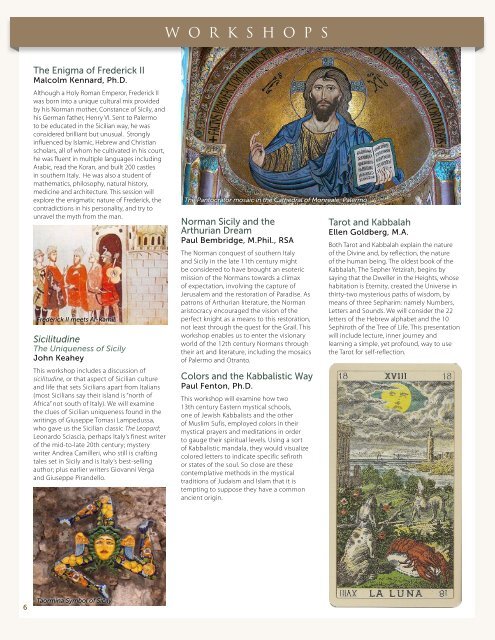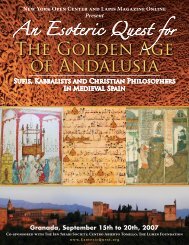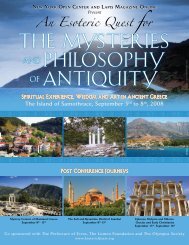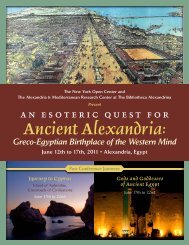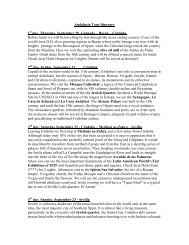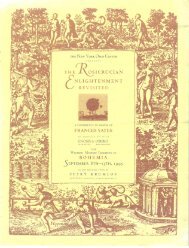Download full color brochure - Esoteric Quest
Download full color brochure - Esoteric Quest
Download full color brochure - Esoteric Quest
Create successful ePaper yourself
Turn your PDF publications into a flip-book with our unique Google optimized e-Paper software.
6<br />
the Enigma of Frederick ii<br />
Malcolm Kennard, Ph.D.<br />
Although a Holy Roman Emperor, Frederick II<br />
was born into a unique cultural mix provided<br />
by his Norman mother, Constance of Sicily, and<br />
his German father, Henry VI. Sent to Palermo<br />
to be educated in the Sicilian way, he was<br />
considered brilliant but unusual. Strongly<br />
influenced by Islamic, Hebrew and Christian<br />
scholars, all of whom he cultivated in his court,<br />
he was fluent in multiple languages including<br />
Arabic, read the Koran, and built 200 castles<br />
in southern Italy. He was also a student of<br />
mathematics, philosophy, natural history,<br />
medicine and architecture. This session will<br />
explore the enigmatic nature of Frederick, the<br />
contradictions in his personality, and try to<br />
unravel the myth from the man.<br />
Frederick II meets Al-Kamil<br />
Sicilitudine<br />
The Uniqueness of Sicily<br />
John Keahey<br />
This workshop includes a discussion of<br />
sicilitudine, or that aspect of Sicilian culture<br />
and life that sets Sicilians apart from Italians<br />
(most Sicilians say their island is “north of<br />
Africa” not south of Italy). We will examine<br />
the clues of Sicilian uniqueness found in the<br />
writings of Giuseppe Tomasi Lampedussa,<br />
who gave us the Sicilian classic The Leopard;<br />
Leonardo Sciascia, perhaps Italy’s finest writer<br />
of the mid-to-late 20th century; mystery<br />
writer Andrea Camilleri, who still is crafting<br />
tales set in Sicily and is Italy’s best-selling<br />
author; plus earlier writers Giovanni Verga<br />
and Giuseppe Pirandello.<br />
Taormina Symbol of Sicily<br />
W o r k s h o P s<br />
The Pantocrator mosaic in the Cathedral of Monreale, Palermo<br />
norman Sicily and the<br />
Arthurian Dream<br />
Paul Bembridge, M.Phil., rSA<br />
The Norman conquest of southern Italy<br />
and Sicily in the late 11th century might<br />
be considered to have brought an esoteric<br />
mission of the Normans towards a climax<br />
of expectation, involving the capture of<br />
Jerusalem and the restoration of Paradise. As<br />
patrons of Arthurian literature, the Norman<br />
aristocracy encouraged the vision of the<br />
perfect knight as a means to this restoration,<br />
not least through the quest for the Grail. This<br />
workshop enables us to enter the visionary<br />
world of the 12th century Normans through<br />
their art and literature, including the mosaics<br />
of Palermo and Otranto.<br />
Colors and the Kabbalistic Way<br />
Paul Fenton, Ph.D.<br />
This workshop will examine how two<br />
13th century Eastern mystical schools,<br />
one of Jewish Kabbalists and the other<br />
of Muslim Sufis, employed <strong>color</strong>s in their<br />
mystical prayers and meditations in order<br />
to gauge their spiritual levels. Using a sort<br />
of Kabbalistic mandala, they would visualize<br />
<strong>color</strong>ed letters to indicate specific sefiroth<br />
or states of the soul. So close are these<br />
contemplative methods in the mystical<br />
traditions of Judaism and Islam that it is<br />
tempting to suppose they have a common<br />
ancient origin.<br />
tarot and Kabbalah<br />
Ellen Goldberg, M.A.<br />
Both Tarot and Kabbalah explain the nature<br />
of the Divine and, by reflection, the nature<br />
of the human being. The oldest book of the<br />
Kabbalah, The Sepher Yetzirah, begins by<br />
saying that the Dweller in the Heights, whose<br />
habitation is Eternity, created the Universe in<br />
thirty-two mysterious paths of wisdom, by<br />
means of three Sepharim: namely Numbers,<br />
Letters and Sounds. We will consider the 22<br />
letters of the Hebrew alphabet and the 10<br />
Sephiroth of the Tree of Life. This presentation<br />
will include lecture, inner journey and<br />
learning a simple, yet profound, way to use<br />
the Tarot for self-reflection.


